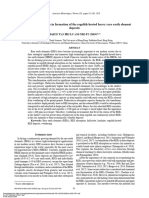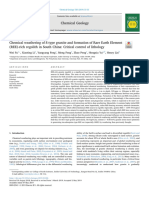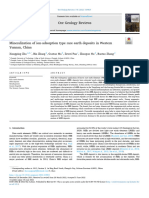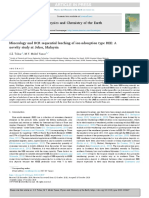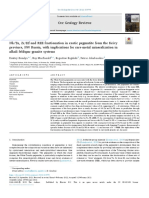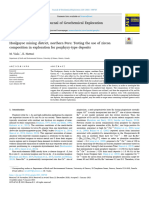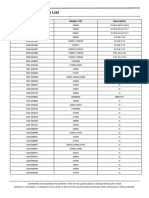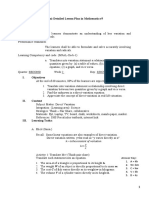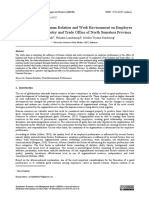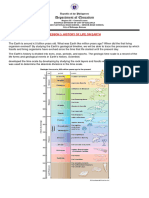Highlights and Breakthroughs Regolith-Hosted Rare-Earth Elements: The Phyllosilicate Connection
Highlights and Breakthroughs Regolith-Hosted Rare-Earth Elements: The Phyllosilicate Connection
Uploaded by
Naiga Erios SembatyaCopyright:
Available Formats
Highlights and Breakthroughs Regolith-Hosted Rare-Earth Elements: The Phyllosilicate Connection
Highlights and Breakthroughs Regolith-Hosted Rare-Earth Elements: The Phyllosilicate Connection
Uploaded by
Naiga Erios SembatyaOriginal Title
Copyright
Available Formats
Share this document
Did you find this document useful?
Is this content inappropriate?
Copyright:
Available Formats
Highlights and Breakthroughs Regolith-Hosted Rare-Earth Elements: The Phyllosilicate Connection
Highlights and Breakthroughs Regolith-Hosted Rare-Earth Elements: The Phyllosilicate Connection
Uploaded by
Naiga Erios SembatyaCopyright:
Available Formats
American Mineralogist, Volume 105, pages 1–2, 2020
Highlights and Breakthroughs
Regolith-hosted rare-earth elements: The phyllosilicate connection
W. Crawford Elliott1,*
1
Department of Geosciences, Georgia State University, Atlanta, Georgia 30302-3965, U.S.A.
The analyses of all or some of the rare-earth elements (Sc, other industrial uses and materials. Considerable amounts of
Y, and the lanthanide series) have been used to understand the HREE are being mined from the extraction of HREE ion-
petrologic processes at many scales ranging from planetary sorbed regolith in southeast (SE) China. The ease of extraction
studies to studies of the Earth’s crust (e.g., McLennan and makes these deposits highly attractive as sources of the HREE.
Taylor 2012). Though thought to be insoluble or immobile at The ion-sorbed HREE accounts for approximately 70% and
increased temperatures and pressures, the geochemical behavior more of the current supplies of the HREE. A growing body of
of the rare earth elements (REE) have varied relative to each work is documenting the solubility and the adsorption of these
other in many subtle ways. Specific rare earth elements (Ce, seemingly insoluble REE in sedimentary rocks, regolith, and
Eu) have had distinct redox behaviors within crustal rocks. low-temperature regimes. Further study of their solubility will
Their geochemical and mineralogic attributes have made them lead to the increased development of these non-traditional or
highly useful for many petrologic studies of the Earth’s crust. novel deposits of the REE in sedimentary/regolith/soil systems.
An entirely different picture of the REE’s geochemical and Given the foregoing ideas regarding the increased solubility
mineralogic behavior has been evident in weathering and diage- of the REE and their formation as ion-sorbed REE or formation
netic systems. This general idea of the increased solubility of the as secondary REE-minerals in sedimentary and regolith settings,
REE due to weathering or diagenetic temperatures can be traced the paper by Martin Yan Hei Li and Mei-Fu Zhou (2020, this
at least to the 1960s (Burkov and Podporina 1967). The release issue) is a most welcomed contribution for many reasons. Li
of REE from bedrock sources (granite and sedimentary rocks) and Zhou took on the formidable task of trying to understand
and their precipitation as secondary REE-phases and/or REE as the role of clay minerals in adsorbing REE in the regolith-
ion-sorbed has been described recently in the Piedmont regolith hosted REE deposits in SE China. Briefly, Li and Zhou found
and in mined kaolin beds in the Georgia Coastal Plain (e.g., Bern the halloysite-rich lower regolith adsorbed the REE and heavy
et al. 2017; Cheshire et al. 2018). This increased solubility of rare-earth elements (HREE) weathered from the parent granite.
the REE might be a paradigm shift relative to the conventional These REE were later desorbed as the halloysite phases were
thinking about the occurrences of the REE observed from the transformed to kaolinite in the upper regolith. These released
petrologic and geochemical studies of crustal rocks. REE migrated or translocated to the deeper regolith containing
The REE have been regarded recently as critical metals for halloysite. These combined mineralogical, geochemical, and
important technologies and products (e.g., batteries, magnets, the pedogenic processes forming this regolith were thought to
wind turbines, LED, phosphor for screens; Lucas et al. 2015). have created the large concentrations of REE whose total REE
The strategic nature of the REE has stimulated further think- on average is 2500 ppm.
ing to understand both traditional occurrences of the REE as The sorption of metal ions at the interlayer sites of phyllosili-
well as to explore for new and non-traditional occurrences for cate minerals having high layer charge is known well. However,
the REE. The REE have been mined from well-known depos- the sorption of REE by halloysite stressed the importance of
its (e.g., Bayan Obo, China; Fan et al. 2016; Mountain Pass, edge/surface sorption processes and high specific surface area
California). Examples of recently studied nontraditional and of the individual grains. These new results on regolith-hosted
sizeable occurrences of the REE included: the occurrences REE REE should stimulate further thinking and investigations regard-
as diagenetically formed REE-phosphate phases in kaolin; the ing the about metal-phyllosilicate mineral sorption processes
presence of REE in kaolin mine waste; and the sizeable amounts at the atom scale. Li and Zhou further noted that compounds
of the REE in coal, coal fly ash, heavy mineral sand deposits, forming stable complexes with halloysite would point to more
alluvial sediments, and in deep sea sediments (e.g., Seredin and environmentally friendly extraction processes to recover the
Dai 2012; Bern et al. 2016; Hower et al. 2016; Cheshire et al. REE from these clays.
2018; Elliott et al. 2018; Shah et al. 2018; Takaya et al. 2018; Finally, this paper was also a welcomed contribution in that
Van Gosen and Ellefsen 2018; Liu et al. 2019). the authors provided a useful review of the site description to
The REE-enriched fractions of these heavy mineral sand these regolith-hosted REE deposits. They noted the occurrences
deposits in southern Georgia and the resumption of REE mining of ion-sorbed REE elsewhere in south China and other tropical
at Mountain Pass are currently the only domestic sources of the settings (SE Asia, Madagascar, Malawi, and Brazil). More in-
REE being mined in the U.S. Consequently, the U.S. is highly teresting and germane to the American Mineralogist readership,
dependent on international sources for the REE, particularly the authors stressed the phyllosilicate mineralogy connection
the HREE (Gd, Lu) used in many technologies, materials, and for understanding the ion-sorption of these seemingly insoluble
REE. Li and Zhou’s results should stimulate further thought on
* E-mail: wcelliott@gsu.edu the release and sorption of these seemingly insoluble REE onto
0003-004X/20/0001–001$05.00/DOI: http://dx.doi.org/10.2138/am-2020-7312 1
Downloaded from https://pubs.geoscienceworld.org/msa/ammin/article-pdf/105/1/1/4910160/am-2020-7312.pdf
by University of Connecticut user
on 05 January 2020
2 ELLIOTT: REGOLITH-HOSTED RARE-EARTH ELEMENTS
clay particles at the atom or nanoscale. This new model will be stoker ash. International Journal of Coal Geology, 189, 75–82.
Li, M.Y.H., and Zhou, M-F. (2020) The role of clay minerals in formation of the
useful to find further REE prospects in regolith settings. regolith-hosted heavy rare earth element deposits. American Mineralogist,
105, 92–108.
Acknowledgments Liu, P., Huang, R.X., and Tang Y.Z. (2019) Comprehensive understanding of
The author thanks James Renner (Southern Ionics Minerals, LLC) for some rare earth elements (REE) occurrence in coal fly ashes and implications for
interesting discussions regarding the occurrences of the rare earth elements in REE extractability. Environmental Science & Technology, 53, 9, 5369–5377.
alluvial and beach sands in southern Georgia. Lucas, J., Lucas, P., LeMercier, T., Rollat, A., and Davenport, W. (2015) Rare
Earths—Science, Technology and Use. Elsevier, 370 p.
McLennan, S.M., and Taylor, S.R. (2012) Geology, geochemistry and natural
References cited abundances of the rare-earth elements. In D.A. Atwood, Ed., The Rare Earth
Bern, C., Shah, A.K., Benzel, W.M., and Lowers, H.A. (2016) The distribution and Elements. Wiley.
composition of REE-bearing minerals in placers of the Atlantic and Gulf Coast Seredin, V.V., and Dai, S. (2012) Coal deposits as potential alternative sources of
Coastal Plains. Journal of Geochemical Exploration, 162, 50–61. lanthanides and yttrium. International Journal of Coal Geology, 94, 67–93.
Bern, C.R., Yesavage, T., and Foley, N.K. (2017) Ion-adsorption REEs in regolith Shah, A.K., Bern, C.R., VanGosen, B.S., Daniels, D.L., Benzel, W.M., Budahn, J.R.,
of the Liberty Hill pluton, South Carolina. USA: An effect of hydrothermal Ellefsen, J.J., Karst, A., and Davis, R. (2018) Rare earth mineral potential in the
alteration. Journal of Geochemical Exploration, 172, 29–40. doi:10.1016/j. southeastern US Coastal Plain, from integrated geophysical, geochemical and
gexplo.2016.1009.1009. geologic approaches. Geological Society of America Bulletin, 129, 1140–1157.
Burkov, V.V., and Podporina, Ye.K. (1967) Rare-earths in granitoid residuum. Takaya, Y., Yasukawa, K., Kawasaki, T., Fujinga, K., Ohta, J., Usui, Y., Nakamura,
Doklady Academy of Sciences. U.S.S.R., Earth Science Section, 177, 214–216. K., Kimura, J-I., Chang, Q., Hamada, M., and others. (2018) The tremendous
Cheshire, M.C., Bish, D., Cahill, J.F., Kertez, V., and Stack, A.G. (2018) Geochemi- potential of deep-sea mud as a source of rare-earth elements. Scientific
cal evidence for the rare-earth element mobilization during kaolin diagenesis. Reports, 8, 5763.
ACS Earth and Space, 3, 506–520. Van Gosen, B.S., and Ellefsen, K.J. (2018) Titanium mineral resources in the
Elliott, W.C. Gardner, D.J., Malla, P., and Riley, E. (2018) A new look at the oc- heavy-mineral sands in the Atlantic Coastal Plain of the Southeastern United
currences of the rare-earth elements in the Georgia Kaolins. Clays and Clay States. Scientific Investigations Report 2018-5045. U.S. Department of the
Minerals, 66, 245–260. Interior, 32 pp.
Fan, H-R., Yang, K-F., Hu, F-F., Liu, S., and Wang, K-Y. (2016) The giant Bayan
Obo Nb0Fe deposit, China: Controversies and ore genesis. Geoscience Fron-
tiers, 7, 335–344. Manuscript received October 2, 2019
Hower, J.C., Qian, D., Briot, N.J., Henke, K.R., Hood, M.M., Taggard, R.K., and Manuscript accepted October 19, 2019
Hsu-Kim, H. (2016) Rare earth element associations in the Kentucky State Manuscript handled by Don Baker
Interested in minerals, rocks, and the processes that form them? Learn about the
Mineralogical
Awards
Short Courses
Specialist Groups
Collector’s Corner
Mineralogy 4 Kids
Society of
Member Discounts
Ask-a-Mineralogist
MSA-Talk list-serve
Elements – magazine
Lectureship Program
America
Student Research Grants
Monographs and Textbooks
Symposia and Special Sessions
American Mineralogist - journal
Reviews in Mineralogy and Geochemistry
www.minsocam.org
Mineralogical Society of America 3635 Concorde Pkwy Ste 500 Chantilly VA 20151-1110 USA
phone: +1 (703) 652-9950 fax: +1 (703) 652-9951
(Sliced and polished, color-zones tourmaline, Plumbago Mining’s Newry or Mt. Mica deposit, Newry, Maine, U.S.A.)
American Mineralogist, vol. 105, 2020
Downloaded from https://pubs.geoscienceworld.org/msa/ammin/article-pdf/105/1/1/4910160/am-2020-7312.pdf
by University of Connecticut user
on 05 January 2020
You might also like
- Dragon Ball Z (Sagas Completas)Document2 pagesDragon Ball Z (Sagas Completas)Yerson Guerra100% (1)
- Booth's Algorithm - Multiplication & DivisionDocument27 pagesBooth's Algorithm - Multiplication & Divisionnaveen86% (22)
- Physicochemical Variation of Clay Minerals and Enrichment of Rare Earth Elements in Regolith Hosted Deposits: Exemplification From The Bankeng Deposit in South ChinaDocument15 pagesPhysicochemical Variation of Clay Minerals and Enrichment of Rare Earth Elements in Regolith Hosted Deposits: Exemplification From The Bankeng Deposit in South ChinaNaiga Erios SembatyaNo ratings yet
- Hei LiDocument17 pagesHei LiNaiga Erios SembatyaNo ratings yet
- Bao_Zhao_2008_Geochemistry of mineralization with exchangeable REY in the weathering crustsDocument18 pagesBao_Zhao_2008_Geochemistry of mineralization with exchangeable REY in the weathering crustsycles.cmNo ratings yet
- Regolith-Hosted Rare Earth Exploration in The Chilean Coastal Range of The Central AndesDocument17 pagesRegolith-Hosted Rare Earth Exploration in The Chilean Coastal Range of The Central AndesNaiga Erios SembatyaNo ratings yet
- Hei Li, 2017Document2 pagesHei Li, 2017Leyla Weibel PuentesNo ratings yet
- Lateritic, Supergene Rare Earth Element DepositsDocument20 pagesLateritic, Supergene Rare Earth Element DepositsArfinsa Ainurzana100% (2)
- Chemical Geology: A A A A A A B BDocument19 pagesChemical Geology: A A A A A A B BNaiga Erios SembatyaNo ratings yet
- Ore Geology Reviews: Xiangping Zhu, Bin Zhang, Guotao Ma, Zewei Pan, Zhaoguo Hu, Baotao ZhangDocument14 pagesOre Geology Reviews: Xiangping Zhu, Bin Zhang, Guotao Ma, Zewei Pan, Zhaoguo Hu, Baotao ZhangNaiga Erios SembatyaNo ratings yet
- Ore Geology Reviews 105 (2019) 467-486Document20 pagesOre Geology Reviews 105 (2019) 467-486periskarasmaNo ratings yet
- Trace Element Geochemistry of Iron Oxy Hydroxides in Ni Co - 2022 - Ore GeolDocument29 pagesTrace Element Geochemistry of Iron Oxy Hydroxides in Ni Co - 2022 - Ore GeolHasanuddin NurdinNo ratings yet
- 20 Hikov GeoSci 2018Document3 pages20 Hikov GeoSci 2018EdilberNo ratings yet
- A Comparison of Global Rare Earth Element REE Resourc 2020 Journal of AsiaDocument15 pagesA Comparison of Global Rare Earth Element REE Resourc 2020 Journal of AsiaMiguel Montalván AraozNo ratings yet
- Vol 2 - Cont. J. Earth Sci 2Document24 pagesVol 2 - Cont. J. Earth Sci 2wilolud9822No ratings yet
- ReviewArticle PDFDocument7 pagesReviewArticle PDFwaleligneNo ratings yet
- Ore Geology Reviews: SciencedirectDocument18 pagesOre Geology Reviews: SciencedirectLeonardo JaimesNo ratings yet
- 2 A Detrital Heavy Mineral Viewpoint On Sediment Provenance and Tropical Weathering in Se AsiaDocument16 pages2 A Detrital Heavy Mineral Viewpoint On Sediment Provenance and Tropical Weathering in Se AsiaPrades alhamdiNo ratings yet
- Tohar2020 Characterization REE JohorDocument10 pagesTohar2020 Characterization REE JohorNurul 'Ain JabitNo ratings yet
- Geochemical Evidence For K-Metasomatism Related To Uranium Enrichment in Daejeon Granitic Rocks Near The Central Ogcheon Metamorphic Belt, KoreaDocument2 pagesGeochemical Evidence For K-Metasomatism Related To Uranium Enrichment in Daejeon Granitic Rocks Near The Central Ogcheon Metamorphic Belt, KoreaTaufiq Al IdrusNo ratings yet
- 1 s2.0 S0169136823000598 MainDocument20 pages1 s2.0 S0169136823000598 MainJuan UscaNo ratings yet
- Lottermoser 1992Document17 pagesLottermoser 1992rom LeeNo ratings yet
- Whole Rock Compositional Variations in an Upper Mantle Prdtt Horoman HokkaidoDocument22 pagesWhole Rock Compositional Variations in an Upper Mantle Prdtt Horoman Hokkaidozahra mourabitNo ratings yet
- Jin Et Al 2021Document12 pagesJin Et Al 2021Jessica BarcellosNo ratings yet
- Paper PlacerDocument27 pagesPaper PlacerjohnNo ratings yet
- The Role of Fluids in The Formation of Rare Earth Element DepositsDocument4 pagesThe Role of Fluids in The Formation of Rare Earth Element DepositsNaiga Erios SembatyaNo ratings yet
- Resource Geology - 2017 - PadronesDocument23 pagesResource Geology - 2017 - Padronesdanisse.casanovaNo ratings yet
- Tectonic Significance of Australian Rare Earth Element Deposits - Spandler Et Al (2020) PDFDocument16 pagesTectonic Significance of Australian Rare Earth Element Deposits - Spandler Et Al (2020) PDFAndrés BarriosNo ratings yet
- J Lithos 2020 105566Document19 pagesJ Lithos 2020 105566bilalafzal7777_74629No ratings yet
- Effects of Desferrioxamine-B On The Release of Arsenic From Volcanic RocksDocument11 pagesEffects of Desferrioxamine-B On The Release of Arsenic From Volcanic RocksRaul DiazNo ratings yet
- 10 1016/j Oregeorev 2007 10 003Document8 pages10 1016/j Oregeorev 2007 10 003Bhakti PatelNo ratings yet
- Yuh Day 2023 Geol Cascades Depleted MantleDocument5 pagesYuh Day 2023 Geol Cascades Depleted MantleJayNo ratings yet
- ZhaoDocument16 pagesZhaoNaiga Erios SembatyaNo ratings yet
- 1 s2.0 S0169136822000877 MainDocument14 pages1 s2.0 S0169136822000877 MainfreNo ratings yet
- Trazas en Circones en Porfiro de Cobre de ChinaDocument15 pagesTrazas en Circones en Porfiro de Cobre de ChinaEduardo ZappettiniNo ratings yet
- Lithium in Stds (Himalaya)Document12 pagesLithium in Stds (Himalaya)Nirmalya ChatterjeeNo ratings yet
- Hydrothermal-mineralization-in-the-sandstone-hosted-Hangjinqi-uranium-deposit-North-Ordos-Basin-China - 2017 - Ore-Geology-ReviewsDocument23 pagesHydrothermal-mineralization-in-the-sandstone-hosted-Hangjinqi-uranium-deposit-North-Ordos-Basin-China - 2017 - Ore-Geology-ReviewshafidzNo ratings yet
- Journal of Geochemical ExplorationDocument21 pagesJournal of Geochemical ExplorationjuanNo ratings yet
- Ore Geology Reviews: SciencedirectDocument17 pagesOre Geology Reviews: SciencedirectNaiga Erios SembatyaNo ratings yet
- Trace Element Remobilization at The Ok Tedi Porphyry Cu-Au Deposit, Papua New GuineaDocument4 pagesTrace Element Remobilization at The Ok Tedi Porphyry Cu-Au Deposit, Papua New GuineaCésar LópezNo ratings yet
- Evolving Zircon and Thorite Trace Element ChemistryDocument23 pagesEvolving Zircon and Thorite Trace Element ChemistryBebe Beb312No ratings yet
- Lithos: Lan-Chun Huang, Shao-Yong JiangDocument20 pagesLithos: Lan-Chun Huang, Shao-Yong JiangNguyen tiendungNo ratings yet
- 2023, Spry Et Al., Nodular Sillimanite Rocks As Field Indicators To Metamorphosed Massive Sulfide Deposits, Ore Geol RevDocument23 pages2023, Spry Et Al., Nodular Sillimanite Rocks As Field Indicators To Metamorphosed Massive Sulfide Deposits, Ore Geol RevSamuel PierreNo ratings yet
- Jamnagar Bauxites JAESDocument19 pagesJamnagar Bauxites JAESaisyahsnr6No ratings yet
- Chemical Geology: Hua-Yong Chen, Yan-Jing Chen, Mike BakerDocument11 pagesChemical Geology: Hua-Yong Chen, Yan-Jing Chen, Mike Bakerwitchex lenonNo ratings yet
- 4751 Orovan and HollingsDocument6 pages4751 Orovan and HollingsSaulNo ratings yet
- Wang 2021Document14 pagesWang 2021DubNo ratings yet
- 131-Article Text-242-1-10-20190115Document5 pages131-Article Text-242-1-10-20190115abdulqadirghoriNo ratings yet
- GCASierraPGE Lee 2002Document19 pagesGCASierraPGE Lee 2002Tiny EvalNo ratings yet
- JurnalDocument13 pagesJurnalhafidzNo ratings yet
- 1-s2.0-S0169136822001512-mainDocument14 pages1-s2.0-S0169136822001512-mainouedraogoNo ratings yet
- A New Discrimination Scheme For Oceanic Ferromanganese Deposits Using High Field Strength and Rare Earth ElementsDocument32 pagesA New Discrimination Scheme For Oceanic Ferromanganese Deposits Using High Field Strength and Rare Earth ElementsMadhura MuralidharanNo ratings yet
- Martin Et Al. (2019)Document21 pagesMartin Et Al. (2019)Gabriel González GarcíaNo ratings yet
- Challenges For The Producttion of HREEDocument5 pagesChallenges For The Producttion of HREEConstanza SusumiyaNo ratings yet
- Rossman p801 02Document2 pagesRossman p801 02mauricio rojas alvarezNo ratings yet
- 1-s2.0-S1674987119300428-mainDocument32 pages1-s2.0-S1674987119300428-mainb7w4wnzqbdNo ratings yet
- Viala 2021Document12 pagesViala 2021AlexanderNo ratings yet
- The Other IsotopesDocument20 pagesThe Other IsotopesRick HunterNo ratings yet
- A-Type Granites and Related Rocks Evolution of A CDocument30 pagesA-Type Granites and Related Rocks Evolution of A Cjunior.geologiaNo ratings yet
- Grain Morphology of Heavy Minerals From Marine and ContinentalDocument27 pagesGrain Morphology of Heavy Minerals From Marine and ContinentalmarcopumasNo ratings yet
- 2021 Goodenough Et Al Carbonatites and Alkaline Igneous Rocks in Post-CollisionaDocument27 pages2021 Goodenough Et Al Carbonatites and Alkaline Igneous Rocks in Post-CollisionaAsayuki MenezesNo ratings yet
- Advanced Controllers For Quadratic Boost Converter - A Case StudyDocument6 pagesAdvanced Controllers For Quadratic Boost Converter - A Case StudyNishanthi BheemanNo ratings yet
- A 71 Samsung Electrical Part ListDocument12 pagesA 71 Samsung Electrical Part ListIsabel GarciaNo ratings yet
- DLL in Tle Ict 7 Q1 Week 2Document5 pagesDLL in Tle Ict 7 Q1 Week 2Melissa Jean BayobayNo ratings yet
- Preconsolidation StressDocument10 pagesPreconsolidation Stressmho.talebiNo ratings yet
- Direct Variation Semi Detailed Lesson PlanDocument6 pagesDirect Variation Semi Detailed Lesson PlanMary Lyd TiuNo ratings yet
- Benefits of Moti Vation: Instructor: Anna Maneleine Caluscusin Reporter: Pamela M. PalomarDocument12 pagesBenefits of Moti Vation: Instructor: Anna Maneleine Caluscusin Reporter: Pamela M. PalomarXyxy MeimeiNo ratings yet
- Speechtokenizer: Unified Speech Tokenizer For Speech Large Language ModelsDocument18 pagesSpeechtokenizer: Unified Speech Tokenizer For Speech Large Language ModelsbilletonNo ratings yet
- 上海市长宁区2024届高三4月期中教学质量监测英语(二模)答案Document6 pages上海市长宁区2024届高三4月期中教学质量监测英语(二模)答案Zhou DavidNo ratings yet
- Danish Kadah: Road To ExcellenceDocument23 pagesDanish Kadah: Road To ExcellenceSehrish Hassan KhanNo ratings yet
- Telling Time .. DA SIMIRILDocument5 pagesTelling Time .. DA SIMIRILLicinio QuilendaNo ratings yet
- Creative and Critical Thinking Final Report 2013 - ASTI FINALDocument24 pagesCreative and Critical Thinking Final Report 2013 - ASTI FINALRagav RaguNo ratings yet
- Template-QEMS-NURUL FADHILAHDocument7 pagesTemplate-QEMS-NURUL FADHILAHCandroTuaNababanNo ratings yet
- Fish WelfareDocument6 pagesFish Welfare'Oswaldo SosaNo ratings yet
- Selena Singh Resume 2020 1Document1 pageSelena Singh Resume 2020 1api-455942843No ratings yet
- MSDS Gasoline by Shell (2013)Document13 pagesMSDS Gasoline by Shell (2013)Torero02No ratings yet
- Expanded Phantoms - GM BinderDocument19 pagesExpanded Phantoms - GM Binderlukas bentes0% (1)
- Lesson5-Geologic Time Scale (GTS)Document3 pagesLesson5-Geologic Time Scale (GTS)MobileLegends SbNo ratings yet
- Reservoir Eng Labsheet - 2019Document39 pagesReservoir Eng Labsheet - 2019Albert ChongNo ratings yet
- Guided 12-14-2021Document74 pagesGuided 12-14-2021Aya AbouseifNo ratings yet
- Effect of Cold Working On BrassDocument3 pagesEffect of Cold Working On BrassHasnain AliNo ratings yet
- Exelerate TUFSOIL - External - FAQ - Interactive - PDFDocument5 pagesExelerate TUFSOIL - External - FAQ - Interactive - PDFharshalvpatil1612No ratings yet
- Energy CH 7 (Example)Document11 pagesEnergy CH 7 (Example)Wunna Swe100% (1)
- Course Syllabus 2023 - 24 MVKP15Document2 pagesCourse Syllabus 2023 - 24 MVKP15JohnNo ratings yet
- BIRTHDAYDocument6 pagesBIRTHDAYzk9041407No ratings yet
- 1943 Courant Variational Methods For The Solution of Problems of Equilibrium and VibrationsDocument23 pages1943 Courant Variational Methods For The Solution of Problems of Equilibrium and VibrationsBiju BlNo ratings yet
- Respuesta 2Document5 pagesRespuesta 2Escuela CañarNo ratings yet
- On Centrosymmetric and Centroskew MatricsDocument18 pagesOn Centrosymmetric and Centroskew MatricsMELVIN VIDARNo ratings yet
- +Jurnal+Kesehatan 2Document13 pages+Jurnal+Kesehatan 2Gaidha NurfadhilahNo ratings yet



